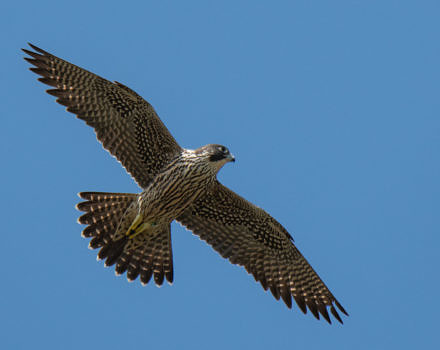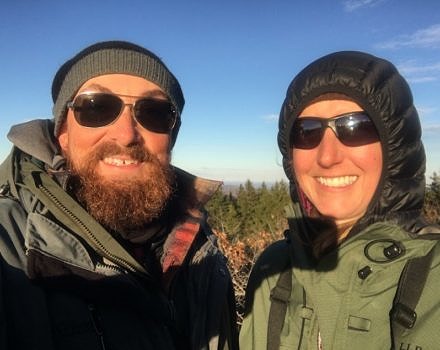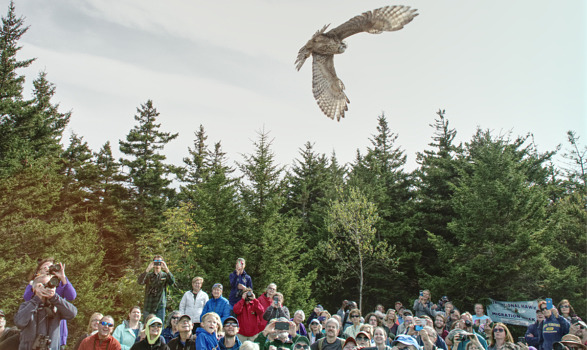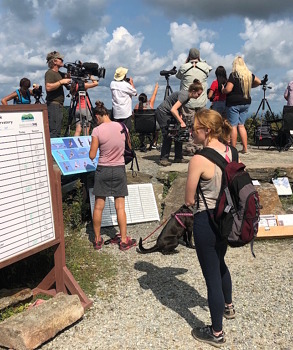A Memorable Year at the Hawk Watch
2018 was a monumental year for the Pack Monadnock Raptor Observatory. Between September 1 and November 20, staff and volunteers logged 455 hours of observation time, tallying 8,842 raptors during this 14th season of raptor migration monitoring at Miller State Park in Peterborough. In addition, more than 4,000 visitors – including nearly 1,000 students from 11 different schools – visited the Observatory to witness the spectacle of the migration, guided by Harris Center naturalists and trained volunteers.
Concerning Counts
2018’s raptor count (8,842) was well below average and down from 2017 (11,804). The two most numerous species, Broad-winged Hawk (6,756) and Sharp-shinned Hawk (668), posted totals well below their long-term averages, as well. Challenging October and November weather may have been responsible for this drop. Observations from other regional monitoring sites suggest that the flight shifted to the west this year – perhaps due to the lack of strong cold fronts and northwest winds that usher birds along.
Biologists continue to track declining migratory Osprey populations, and 2018 was no different at Pack. Pack observers also documented ongoing declines in migrating Northern Harrier, Cooper’s Hawk, Northern Goshawk, and Red-tailed Hawk numbers, strengthening the case for more research and conservation efforts on behalf of these species.
A juvenile Peregrine Falcon soars past the Observatory on Sept. 21, 2018. Note that this bird is banded -- likely as a nestling in the summer of 2018 in Maine or Massaschusetts. (photo © Judd Nathan)

Seasonal Raptor Biologist Chad Witko and volunteer Hillary Siener celebrate a record-setting day of Bald Eagle counts. 23 Bald Eagles were counted from the Pack Monadnock Raptor Observatory on September 24, 2018 -- a new, single-day high count for the site. (photo © Chad Witko)

Promising Trends
Thankfully, the trends were not all negative. Seasonal tallies of Bald Eagles (176) and Golden Eagles (22) soared to record heights, and both species set new high counts for single-day tallies, with 23 Bald Eagles on Sept. 24 and 6 Golden Eagles on Oct. 30. The seasonal count for migrating Rough-legged Hawks (2) tied that species’ previous Pack record, and the American Kestrel – a species in decline – had a surprisingly strong showing (171). In addition to raptors, observers also counted migrating Canada Geese (1,833) and Monarch Butterflies (828). In total, 87 bird species were tallied from the Observatory, including rarities such as Connecticut Warbler and Boreal Chickadee.
Raptor Release Day
The Observatory hosted several events this fall, most notably Raptor Release Day on Sept. 22. This event was timed with International Hawk Migration Week, which saw peak Broad-winged Hawk flights (76% of the total count for 2018). Aside from the wild spectacle occurring overhead, the day also featured the release of several rehabilitated birds of prey in front of 325 thrilled onlookers, a live raptor show with a NH Audubon naturalist, and interpretive programs led by the Harris Center and the SCA NHCorps.
A rehabilitated raptor is returned to the wild on Raptor Release Day 2018. (photo © Andre Moraes)

Visitors take in the sights at the Pack Monadnock Raptor Observatory. (photo © Scott Hecker)

The Bigger Picture
The Pack Monadnock Raptor Observatory is part of an international monitoring effort under the umbrella of the Hawk Migration Association of North America (HMANA). Because of the site’s consistent and long-term dataset, data from Pack are included in the latest Raptor Population Index (RPI), an analysis that paints a picture of how migratory raptor populations are faring throughout the Northeast and eastern Canada. These data are particularly important for tracking migratory populations of several species of conservation concern from year to year.
Thank You
Financial support in 2018 came from the Gilbert Verney Foundation, Nature’s Green Grocer, HMANA’s Hawk Watch Fund, Harlow’s Pub, the Jack Daniels Motor Inn, and from many individual and organizational sponsors, including sustaining donors. Miller State Park and the NH Department of Natural & Cultural Resources continue to support our work onsite, in partnership with NH Audubon. We’re also grateful to our new education partner, the SCA NHCorps. Special thanks is due to Francie & Carl Von Mertens, the Harris Center’s team of volunteer educators, and to all of our many volunteers, sponsors, and program participants.
Learn More
For more detailed information, including an in-depth analysis and population trend graphs for each raptor species we observed, see the full report from the 2018 season.
Contact
For more information on the Pack Monadnock Raptor Observatory, please contact Phil Brown at (603) 525-3499 or by email.


